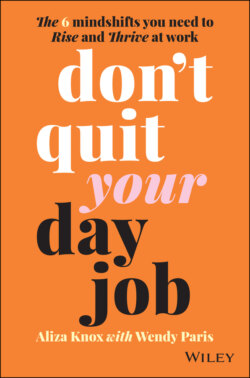Читать книгу Don't Quit Your Day Job - Wendy Paris - Страница 7
The six mindshifts, in brief
ОглавлениеI see the mindshifts in this book as timeless. They are based on my 40 years of work and of listening to and guiding people at all stages of their careers, from recent college grads and mid‐career professionals to leaders within Fortune 100 firms. It includes my stories and those of numerous people who represent a wide range of backgrounds and professions. Each chapter ends with specific takeaways you can apply in your own life. The world of work is always changing, but these essential mindshifts remain the same.
Organisational life is appreciably better now for many than in the recent past. Piruze, who you meet in chapter 1, is an example of how people today are endeavouring to improve the work environment — and winning. She focused on doing an excellent job at work and at home, and designing a role that would not mean forfeiting the time she needed in either realm. As she discovered, thriving in both worlds is easier if you are very clear about what you want, present your desires to your boss professionally and clearly (backed by data, if you can find it), and remain flexible and willing to work with the firm to make it a success for everyone.
Stamina is a career superpower and, as I explain in chapter 2, stamina can be built. One important mindset to help build stamina: don't over‐focus on the negative. Another: remember that you have options. As Mariabrisa discovered when she did some ‘job dating’ to see what other options might exist, her skills and experience were far more valuable in the marketplace than she knew.
In chapter 3, you will meet Rahul and learn why I offered him a job while we were walking through a revolving door together in Beijing (hint: we formed a bond while travelling). You will learn that connections with peers and leaders can be as significant as work performance when it comes to rising and thriving, and that arguably the most important capital you can accrue in business is not financial capital, but social capital.
Yet another story, of a man I call Bo, in chapter 4, shows in some cases how much things haven't changed in the world of work, despite today's focus on employee satisfaction, hybrid teams and diversity. You still will likely have experiences of being treated unfairly, and you have to fight back when you're wronged. No, this does not have to mean taking a firm to court, or even being rehired after an unjust termination. But it does mean standing up for yourself in a way that will let you move forward, and preserve your good relationship with your career.
In chapter 5, you will learn about how people are using movement to rise and thrive — not only moving up, as in preparing for and getting promotions, but also moving from one field to another, and between firms, industries and sectors. You'll also learn how to create movement where you are through ‘job crafting’, which a man I call Tim has done to redesign his current job to include more challenges and creative growth, culminating in higher job satisfaction.
And in chapter 6, you will see how Sierra's request to move to a company's overseas office expanded her professional opportunities and enhanced her personal life — even though she didn't wind up heading to her first dream destination. Like Sierra, your desire to move overseas can be a benefit to your company. Understanding and embracing the truly global nature of work today is key to succeeding and making the kinds of connections that help work feel meaningful.
We are all standing together at a unique, historic inflection point, a moment in which our beliefs about the future of work are shifting as rapidly as the technology we're using to make it happen. This change is exciting and challenging, and it requires a strong set of tools and a new outlook to succeed.
This book is that toolbox. Thank you for opening it and being part of the conversation. Here's to rising and thriving into the future, whatever it may bring.
